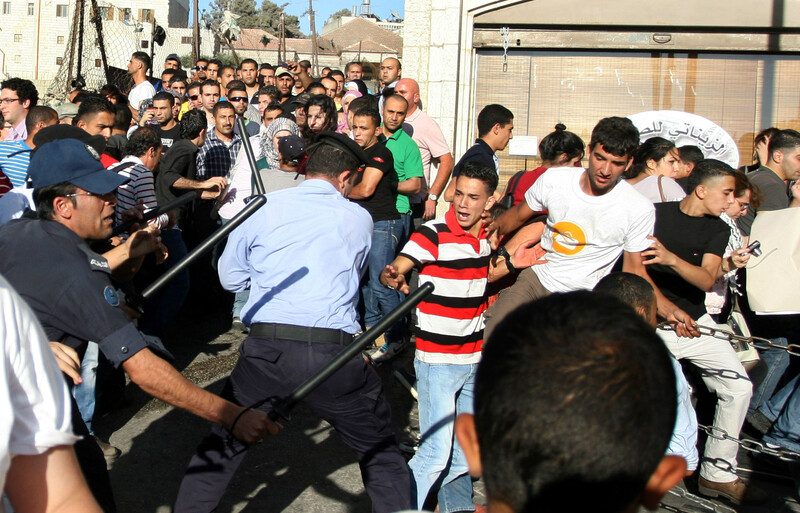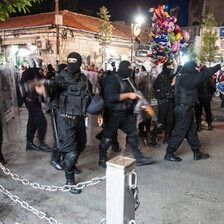The Electronic Intifada Ramallah 8 July 2012

Protests by Palestinians in Ramallah were met with swift, violent repression by Palestinian Authority forces.
APA imagesOn Saturday, 30 June, approximately 1,000 people gathered in al-Manara square in Ramallah to protest the Palestinian Authority’s invitation to Shaul Mofaz, Israel’s deputy prime minister and an indicted war criminal, and demanding an end to negotiations with Israel.
The protest was swiftly and violently repressed by plain-clothed mukhabarat (secret police) thugs, with PA police coordination. The repression took the form of mukhabarat and police beating people with batons and metal chains, sexually assaulting and spitting in the face of female protestors, kidnapping and beating several people, including journalists, in police stations. Many were treated in the hospital for their injuries.
The following day there was another large protest in al-Manara Square. This time the target of anger was not only the PA’s commitment to “negotiations” with Israel, which have benefited nobody other than the colonizing power, but now the PA “security” forces who had violently beaten and humiliated people the day before.
As the march arrived outside the taxi station on al-Irsal street, the police again attacked the demonstration, this time with far more violence than the previous day. There were scenes of chaos as police thugs tore into the crowd, lashing out at anyone within range, beating people on the heads with EU-supplied batons. Mukhabarat again dragged protesters from the crowd, where at least one person was taken to a police station and beaten, before being released for treatment at the hospital.
Unfettered brutality
The violence of the PA is not unexpected, yet it was still shocking to see such unfettered brutality on the streets of Ramallah in the middle of the afternoon. EUPOL COPPS, the EU mission to train the PA security forces, has taken the tactics of repression honed in the streets of Genoa and Belfast and taught them well to its pupils in the PA police.
Another demonstration was called for Tuesday, 3 July, to meet in Clock Square, and this time we would reach the Muqataa, the fortress complex of the PA, and the intended destination of the previous protests.
More than 1,000 people gathered. There were rumors that PA loyalists and off-duty police were going to stage a pro-police demonstration. This is a classic tactic of dictatorial regimes, whereby they can send in their thugs to provoke violence, thus giving the riot police a reason to suppress the protestors, to claim that the police were attacked first, and to allow them to distance themselves from their own thugs. Luckily, the rumored pro-police protest didn’t materialize.
The march was noisy and energetic, and took about half an hour to pass the short distance from al-Manara Square to the street leading to the Muqataa. Many journalists, partly fearing police and mukhabarat attacks, and partly as a protest against the beatings of their colleagues on Saturday and Sunday, wore bullet-proof flak jackets, and some had military-grade helmets dangling from their belts.
Air heavy with tension
As we reached the Muqataa I was tense, as I had been told that there were large groups of plain-clothed men waiting in side streets, and I feared that this would be the start of the attack by regime loyalists. The crowd arrived at the gates of the Muqataa, with many journalists clambering onto walls in expectation of an attack by the regime thugs.
Instead of approaching the gates of the Muqataa, where a small group of uniformed police were flanked by black-clad Presidential Guards holding assault rifles, the demonstrators remained on the road. They stayed in front of the Muqataa and chanted against the Oslo accords, against normalization, against security cooperation with the Israeli army, and against the violence meted out by the mukhabarat and PA police over the last days.
We turned back and slowly marched back towards al-Manara, the air heavy with tension, as the crowd would stop and then surge. The lack of real confrontation was no doubt partly due to the conspicuous absence of the uniformed police who had so enthusiastically beaten unarmed Palestinians over the previous days.
Clearly the police had been given orders to keep a low profile, a sign that the PA understands just how bad it looks to have their police beating and kidnapping Palestinians in the middle of Ramallah. The lack of pale-blue shirts of the PA police, however, did not mean that there were no members of the regime monitoring the demonstrators. On the contrary — there was an abundance of men with ironed shirts, well trimmed beards, and sunglasses either covering their searching eyes, or perched on their crew-cut hair.
As the march returned to al-Manara, the mukhabarat seemed to drop any pretense of being a “secret police.” Instead, they photographed and filmed the crowd all the way along al-Irsal Street. The two solitary uniformed police officers we saw on this stretch of road were standing close to the spot of Saturday and Sunday’s beatings, and I watched one cop in particular as we passed by.
I noticed that the cloth patch on his pale-blue shirt, emblazoned with the crest of the PA police, was ripped: a macabre testament, perhaps, to the fingers that clawed for something to hold onto as the blows, and bodies, fell.
He turned his back as the crowd, chanting and full of energy, passed. He moved to the other side of the road where he put a line of cars between him and the people he had beaten, or at least corralled into corners, only 48 hours before.
Surveillance
Arriving in al-Manara, the crowd chanted as the mukhabarat waited around the square, with some climbing up onto the square’s central monument to film and photograph the crowd. The march was bigger than Saturday and Sunday, with the Palestinian people once again asserting ownership of the street, and reiterating calls for an end to negotiations and security cooperation between the PA and the occupying forces.
The regime knows well that its visible repression of dissent unleashed an anger against the PA that threatens it greatly. The immediate and indiscriminate violence of batons, chains and spit against protesters on Saturday and Sunday, was replaced on Tuesday by a more calculated use of mukhabarat photographing, filming and building profiles of the crowd.
It remains to be seen when the still images and videos in the mukhabarat files will contribute to the influx of bodies in PA prison cells (though already people are being called in for interrogation), and when the chains and batons will return to beat the people in the streets of Ramallah. The crowds yesterday reclaimed the streets, but the sides of this struggle have been chosen: those who, with the weapons and training of Western police forces, violently enforce the policies of the PA on one side; and those who, with their flesh and bones, defend the dignity of the Palestinian people.
Eoin Wilson is a volunteer at Stop the Wall in Ramallah. He is an independent writer and an activist with the We Are All Hana Shalabi network in Scotland, when not in Palestine. This piece is written in his personal capacity.




